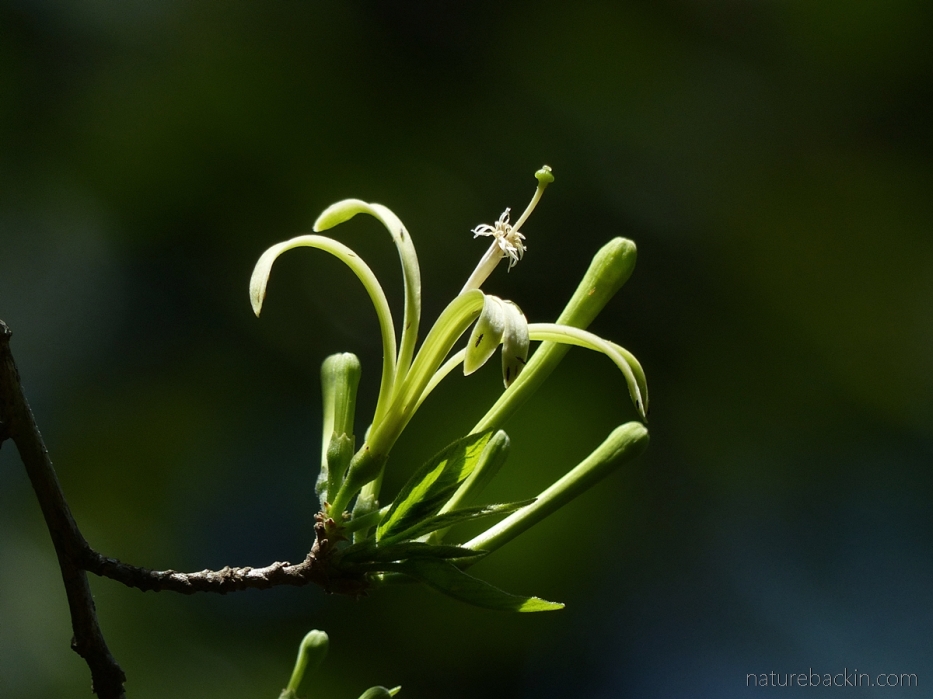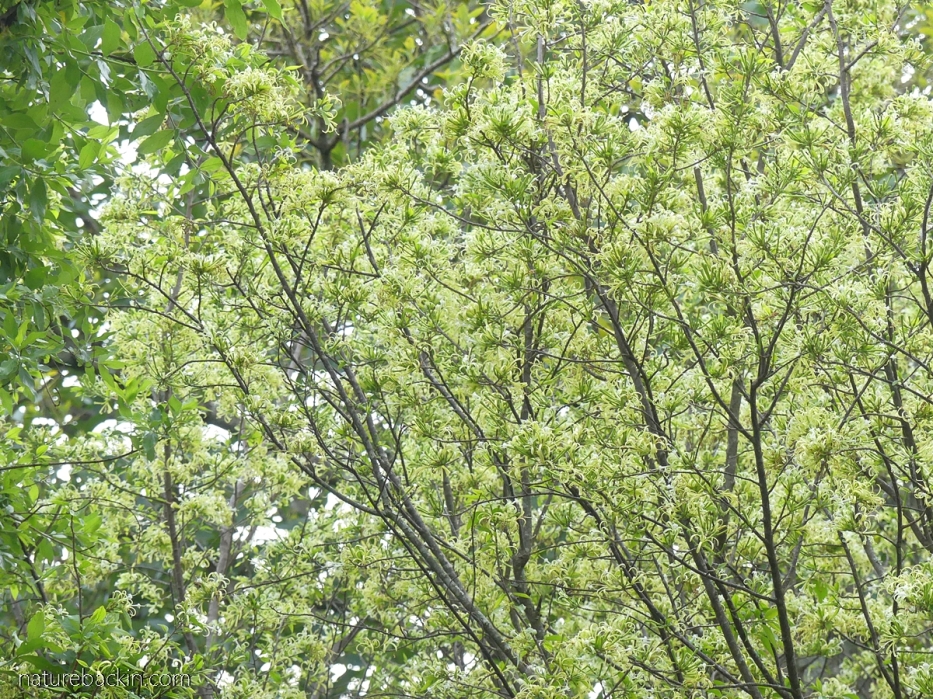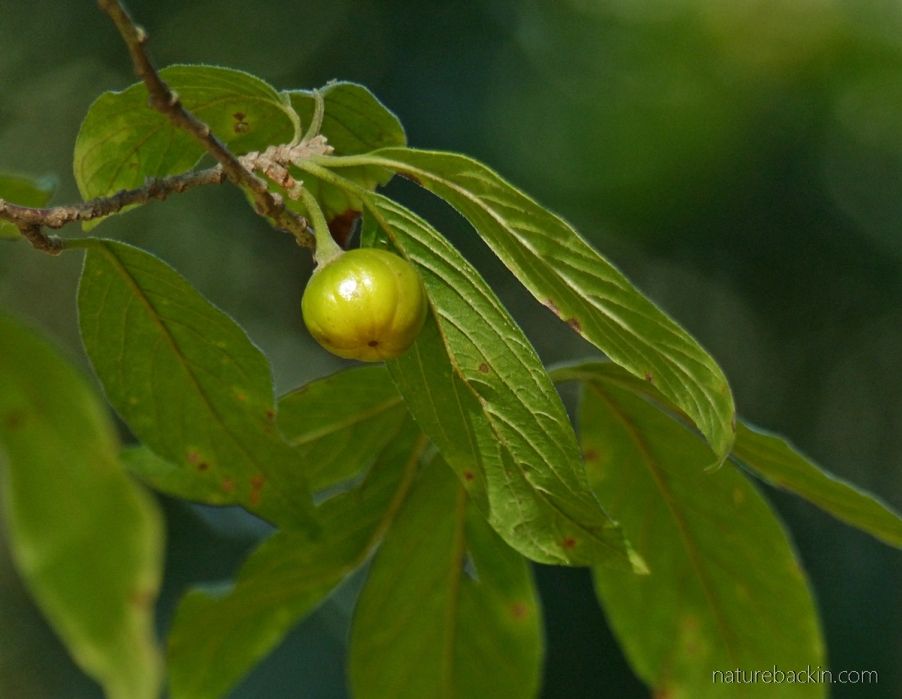Coming into flower now, after dropping its leaves in the very early spring, is the profusely flowering wild honeysuckle-tree. Flowering on bare stems with the new leaves just starting to sprout it puts on a lovely show.

The flowers of the Wild Honeysuckle-tree (Turraea floribunda) are sweetly fragrant. The petals are a subtle shade of green surrounding a long white central tube that is formed by the stamens fused together. At the end of the stamen tube a frill carries the pollen-bearing anthers. The style, which protrudes beyond the tip of the stamen tube, ends in a small knob-like head that receives pollen spread by visiting pollinators, be they insects or birds. According to Boon, the flowers are pollinated by visiting hawk moths and sunbirds.

In the two sources I consulted, Boon describes the colour of the petals as “creamy-green” and Manning says they are a “delicate pistachio-green”. The flowers are borne in clusters of between 2 to 18 flowers with clusters comprising at first just the long slender buds and then a mixture of buds and fully opened flowers.

With the flowers emerging on the bare stems as the new leaves are just starting to sprout, the clusters of buds and flowers are particularly striking against a blue sky.


But equally the flowers are lovely against the green foliage of the surrounding trees. The honey-suckle tree is a forest species and it occurs in the eastern regions of the Eastern Cape and KwaZulu-Natal in South Africa. Its broader range extends as far north as Sudan.

The ‘floribunda’ part of the honeysuckle-tree’s scientific name means ‘prolifically flowering’ and in the early summer it certainly does live up to its name.



With such a profusion of flowers, it is surprising that I have seen very few fruits on the tree. In fact Manning comments that remarkably few fruits are produced for so many flowers. On our tree I have only noticed one or two of the small fruit capsules per season.

As the fruit ripens it splits along its ribs into a kind of star shape with orange seeds attached to each segment. However, I only have a photograph of the split woody capsule after the seeds have dropped.

A couple of weeks ago I found a dry capsule on the ground beneath the tree. I collected it and snapped a photo of it with my phone this evening.

A previous post on porcupines featured our honeysuckle-tree as the trunk had been gnawed on by a visiting porcupine (or porcupines) and some of the bark had been chewed right off the base of the trunk. Happily the porcupines seem to have lost interest in the tree and it has not shown any subsequent ill effects.
The tree is multi-stemmed and its greyish bark is decorated with lichen. I took the photo below in the early dusk this evening using my cell phone.

I wish I could convey to you the sweet scent of the flowers. It is easy to imagine them attracting night flying insects, such as hawk moths.
Boon notes that roots and bark are used medicinally to treat rheumatism and heart ailments, and it is used magically to induce trance. From my perspective it certainly is an entrancing tree.


Sources:
Boon, Richard. 2010 (2nd ed.). Pooley’s Trees of Eastern South Africa. Durban: Flora & Fauna; Manning, John. 2015. Turraea floribunda. PlantZAfrica. South African National Biodiversity Institute (SANBI). http://pza.sanbi.org/turraea-floribunda

Posted by Carol









October 31, 2021 at 3:05 pm
Commenting here on the porcupine post you linked us to, Carol, because comments there are closed. I so enjoyed the porcupine post. I once found one quill on the ground while in Africa, and was amazed at how huge one quill was. But I rarely see porcupines and never in South Africa, so I really soaked up the videos–so adorable–and information you provided. I never knew quills were used in art, was sorry to hear that, and glad to hear awareness is being generated about it. I hope these unique and beautiful creatures can flourish, and am delighted you have been such a great host in your garden.
LikeLiked by 1 person
November 5, 2021 at 8:35 pm
I gather that the north American porcupines are quite different from the porcupines that we have here.
Our dogs have on more than one occasion learnt the hard way how strong the quills of a porcupine are after tangling with visiting porcupines in the garden, Luckily on the very few occasions this has happened they only had one or two dislodged quills sticking into them – painful but missing their eyes and with no serious injuries, to our relief.
LikeLiked by 1 person
October 31, 2021 at 2:53 pm
I completely soaked up the sweetness of this tree through your grand descriptions, research and heavenly photos, Carol. I think honeysuckle is one of the most delightful plants on earth, and that you have honeysuckle trees there is a true gift. We have the vines here in Calif., wild and cultivated, they’re lovely too. A tree must be truly glorious. Thanks for bringing it alive for us here.
LikeLiked by 1 person
November 5, 2021 at 8:29 pm
Hallo Jet, yes it is a glorious and delightful tree. Of course it is not a ‘true’ honeysuckle in the Lonicera genus, but there are enough similarities to earn it the common name ‘honeysuckle’ 🙂
LikeLiked by 1 person
October 28, 2021 at 10:49 pm
How utterly marvelous. I wish I could enjoy what must be a heavenly aroma. What a delight to have such a beautiful tree in your yard! Rather strange that such a profusion of flowers produces so very few fruit. Is it one of those that needs another tree to pollinate properly perhaps????
LikeLiked by 1 person
October 30, 2021 at 5:47 am
Thanks Gunta. The tree is a delight. The tree can self pollinate so it’s hard to know why there are so few fruits. Perhaps more would deplete the tree and perhaps the seeds they do produce are good at germinating? Another mystery …
LikeLike
October 25, 2021 at 5:01 pm
Such delicate profusion! I love the colours of the blooms, Carol. A pity we can’t smell the scent but I’m sure it’s glorious!
LikeLiked by 1 person
October 26, 2021 at 6:48 pm
Delicate profusion is a nice way to describe it. The sweet scent is delicate too and not as overpowering as some flowers that attract night-flying insects.
LikeLiked by 1 person
October 25, 2021 at 11:07 am
What a beautiful tree, and what an amazingly abundance of flowers. The close up shots of the flowers show that they have a simple beauty. Funnily enough, I cannot recall this tree, and it seems I missed out on seeing such a spectacular plant. Thanks for sharing.
LikeLiked by 1 person
October 26, 2021 at 6:46 pm
Now that you mention it, I can’t recall seeing one of these trees anywhere else – perhaps because they are only really noticeable during the relatively short flowering period, which is during a time when we are usually pretty much at home. We are fortunate that the people we inherited our garden from planted this tree.
LikeLiked by 1 person
October 26, 2021 at 9:37 pm
You are indeed very fortunate having that tree in your garden! It is a pity that it does not produce more seed, and I wonder why that is the case. I’m still in awe at the number of flowers it produces!
LikeLiked by 1 person
October 24, 2021 at 2:46 pm
What a boon to have this tree in your garden. Thank you for telling us about its delights
LikeLiked by 1 person
October 24, 2021 at 7:59 pm
Thanks Mariss – yes it is a special delight in the garden.
LikeLiked by 1 person
October 23, 2021 at 10:13 am
This looks very similar to – though not the same as – wild honeysuckle in southern France. Yes, a marvellous plant!
LikeLiked by 1 person
October 24, 2021 at 7:55 pm
It is marvelous and one of the joys of this season.
LikeLiked by 1 person
October 23, 2021 at 6:20 am
Green flowers are so unusual, or maybe not, but seem so because they don’t stand out like other colors. These are very beautiful and I can imagine the scent is wonderful too. I’m glad your tree survived the attack of the hungry porcupines.
LikeLiked by 1 person
October 24, 2021 at 7:54 pm
I think that is right – we tend to overlook green or greenish flowers. However, this tree compensates with the sheer number of flowers and the lovely scent. Yes, I am happy that the porcupines didn’t completely ring-bark the base of the tree. Although in 20 years here I have only seen one tree that died as a result of porcupines stripping the bark.
LikeLiked by 1 person
October 22, 2021 at 2:09 pm
Very beautiful Carol..love the scent of this tree 😊
LikeLiked by 1 person
October 24, 2021 at 7:50 pm
Thanks Carol – it has a scent that is at once delicate and yet quite strong.
LikeLike
October 22, 2021 at 4:39 am
One of my favourite trees! Lovely post, thank you Carol! xxx
LikeLiked by 1 person
October 24, 2021 at 7:49 pm
Thanks Christeen – yes it definitely is a favourite xxx
LikeLiked by 1 person
October 22, 2021 at 4:32 am
Beautifully photographed and described. I am glad you have a specimen to enjoy in your garden – something worth look forward to each year.
LikeLiked by 1 person
October 24, 2021 at 7:49 pm
Thanks Anne – this year it kind of took me by surprise when I suddenly noticed it was in flower!
LikeLiked by 1 person
October 22, 2021 at 12:27 am
What a lovely, delicate flower and graceful tree in bloom. Your photos are superb, Carol, I only wish I could smell its scent!
LikeLiked by 1 person
October 21, 2021 at 8:21 pm
Amazing number of blooms! Very pretty, Carol.
LikeLiked by 1 person
October 24, 2021 at 7:46 pm
Thanks Sandy. They are astonishingly prolific flowerers.
LikeLiked by 1 person